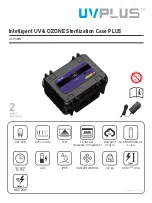
OZONE-Equipment Damage Hazard.
1. OZONE can cause color shift or structural degradation of plastic materials
2. OZONE can cause color shift or structural degradation of resin materials
3. OZONE can cause color shift or structural degradation of leatherwear
4. OZONE can cause color shift or structural degradation of organic compounds materials
5. High concentrations of ozone for a long time can cause electronic products function damage
NOTES:
1. The design of this product based on IEC 62471:2006 Photobiological safety of lamps and lamp
systems and other international standards
2. This product utilizes the ultraviolet rays LED , which emits UV-C rays with peak value wave length at
275nm to disinfect
3. Ultraviolet LED is a relatively tight and fragile electronic component, users should avoid the impact on
the product resulting in product failure.
4. The design of this product is according to Code of Federal Regulations Title 21, Volume 8 by US FDA,
California Code of Regulations Title 17 Public Health, and IEC 62368-1[4] 7.3 and other international
standards
5. According to code of federal Regulations Title 21, Volume 8, ozone is a toxic gas, according to the FDA.
Although ozone has been reported to have adverse physiological effects on the central nervous
system, heart and vision, its main physiological effect is to stimulate the mucous membranes.
Inhalation of ozone causes enough irritation to the lungs, leading to pulmonary edema. The onset of
pulmonary edema is usually delayed by several hours after exposure; As the hazards of ozone are
widely understood, people pay full attention to the use of ozone.
6. At Ozone concentrations of 0.02PPM (0.04mg/m³), ozone can be smelled by people with acute
olfactory senses, at 0.15PPM (0.32mg/m³), ozone can be smelled by the general population, at
1-10PPM (2.14 - 21.4mg/m³) ozone has reached the "stimulus range", and can be clearly smelled, at
10PPM (21.4mg/m³) ozone has reached the "toxic range" or more "poisonous range". The odor of
ozone is not a reliable warning indicator due to the possibility of olfactory fatigue
7. Long term occupied enclosed spaces, such as houses, apartments, hospitals and offices, should have
ozone volumes below 0.1mg/m³ (0.05PPM). The ozone concentration in the workplace, i.e.
occupational exposure limit, is 0.1PPM
8. The amount of space used by the equipment used to place and use this device should not be less than
20m³ to ensure that the ozone remaining in the equipment has sufficient space to be decomposed to a
safe level when the cabinet door is opened
9. When opening the equipment for ozone disinfection, make sure that the equipment is in a well
ventilated environment. If the equipment cannot be ensured to be in a well-ventilated environment,
only open the cabinet door at least 30 minutes after an ozone disinfection session has finished
10. Ozone is unstable, breaks down rapidly at high temperatures, slowly breaks down to (oxygen) at room
temperature, has a half-life of about 16 minutes in 1% of ozone solution and about 25 minutes in the
air.
11. Pure ozone, if receives impact or friction, will explode and decompose. High concentrations of ozone
when heated is also prone to explosion. But as long as care is taken, such accidents are rather rare.
Ozone should not have high concentrations of flammable and explosive gases at the disinfection site
when it is used for air disinfection.










